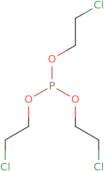Tris (2-chloroethyl) phosphite
CAS: 140-08-9
Ref. 3D-FT32569
| 2ml | Descontinuado | ||
| 5ml | Descontinuado | ||
| 10ml | Descontinuado | ||
| 25ml | Descontinuado | ||
| 50ml | Descontinuado |
Informação sobre produto
- 2-Chloroethanol phosphite (3:1)
- Brn 1704979
- Ccris 5949
- Clp 1
- Ethanol, 2-chloro-, 1,1',1''-phosphite
- Ethanol, 2-chloro-, 1,1′,1′′-phosphite
- Ethanol, 2-chloro-, phosphite
- Ethanol, 2-chloro-, phosphite (3:1)
- Hsdb 2584
- Nsc 6514
- Ver mais sinónimos
- Phosphorous acid, tris(2-chloroethyl) ester
- Tri(2-chloroethyl) phosphite
- Tris(2-chloroethyl)ester of phosphorus acid
- Tris(beta-chloroethyl) phosphite
- Tris(chloroethyl) phosphite
- Tris(β-chloroethyl) phosphite
Tris (2-chloroethyl) phosphite is a carbamate insecticide that inhibits the growth of plants. It prevents the synthesis of proteins by inhibiting the activity of acetylcholinesterase and cholinesterase enzymes, which are responsible for breaking down acetylcholine. This leads to accumulation of acetylcholine at nerve endings, resulting in paralysis and death. Tris (2-chloroethyl) phosphite has been shown to be toxic to humans, with health effects ranging from skin irritation to liver and kidney damage. The chemical is also an eye irritant and may cause respiratory tract irritation at high concentrations. Tris (2-chloroethyl) phosphite can react with hydrogen chloride or phosphorus pentachloride to produce hazardous substances such as hydrogen chloride gas or phosphorus oxychloride gas. Tris (2-chloroethyl) phosphite has been found in test samples collected near industrial sites, including wastewater treatment plants that use phosphate precipitation





